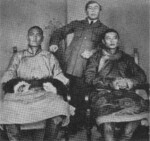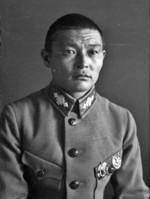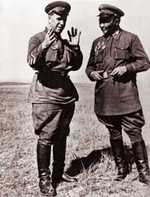Choibalsan
| Given Name | Choibalsan |
| Born | 10 Sep 1937 |
| Died | 26 Jan 1952 |
| Country | China |
| Category | Government |
| Gender | Male |
Contributor: C. Peter Chen
ww2dbaseDugar (patronym Khorloogiin) was born as the youngest of four children to unmarried herdswoman in Achit Beysiyn, Mongolia, Qing Dynasty China in 1895. At the age of 13, he received the religious name Choibalsan as he entered the Buddhist monastery of San Beysiyn Kh├╝ree, where he received training to become a Lama; he would use the name Choibalsan for the remainder of his life. In 1913, he escaped the monastery and arrived at Kh├╝ree (renamed Ulaanbaatar in 1924), where he met a teacher, Nikolai Danchinov, of Buryat ethnicity, who enrolled him in the Russian consulate's Russian-Mongolian Translators School out of sympathy. Between 1914 and 1917, he studied at a gymnasium in Irkutsk, Russia. In 1917, communist separatists called for young expatriates to return to fight in the upcoming rebellion; Choibalsan answered the call, eventually joining the Konsulyn Denj resistance group as the group's main Russian translator. Shortly after, he joined a newly founded resistance group named Z├╝├╝n Kh├╝re. In 1920, Z├╝├╝n Kh├╝re renamed itself the Mongolian People's Party. In late Jun 1920, he traveled with six other leading Mongolian nationalists (the group was later named "First Seven") to Irkutsk to make contact with the Soviets in order to solicit support; Choibalsan and S├╝khbaatar would remain in Irkutsk for military training for six months. On 5 Feb 1921, troops loyal to the anti-Bolshevik Russian warlord (former baron and lieutenant general of the Russian Empire) Roman von Ungern-Sternberg drove out the Chinese garrisons at Kh├╝ree. In response, the Soviet Union officially endorsed the Mongolian People's Party. Choibalsan and S├╝khbaatar were transferred to Troitskosavsk (now Kyakhta), Russia to coordinate activities to recruit new fighters; during this time, Choibalsan regularly entered into Chinese territory to meet rebels in Kh├╝ree and to bring S├╝khbaatar's family members to Troitskosavsk. At the first congress of the Mongolian People's Party, which took place in Troitskosavsk in early Mar 1921, he was made a member of the provisional revolutionary government and the deputy chief of the 400-strong para-military organization Mongolian People's Army (which was commanded by S├╝khbaatar). In mid-1921, he commanded a small detachment in a larger campaign involving Soviet forces and Ungern-Sternberg's forces in western Mongolia. He was likely to be present when Soviet forces captured Ungern-Sternberg on 20 Aug 1921. Later in 1921, he was named the Chairman of the Mongolian Revolutionary Youth League.
ww2dbaseAt this time, although Mongolia remained nominally Chinese territory, it enjoyed autonomy (with heavy Soviet influence) during this period as the Republic of China was occupied by various power struggles in China Proper.
ww2dbaseIn 1921, Choibalsan married seamstress Borotologai.
ww2dbaseIn 1923, Choibalsan was sent to a Moscow Military Academy for further training. In 1924, he was made the commander of the People's Revolutionary Forces. Between 1924 and 1928, he was also a member of the Presidium of the State Great Hural from 1924 to 1928 and as member of the Central Committee of the party, now renamed Mongolian People's Revolutionary Party. In 1929, he was made the Chairman of the Presidium of the State Little Hural, which was the head of state; in this role, he implemented collectivization policies and persecuted Buddhists.
ww2dbaseIn 1929, Choibalsan began an affair with the actress Diwa, which led to a divorce with Borotolgai in 1935. He would later marry G├╝ndegmaa in 1935.
ww2dbaseHaving stepped down in mid-1930, between 1931 and 1935, Choibalsan served as the Minister of Livestock and Agriculture; in this role, he forced traditional herders off of the steppes and into badly managed collective farms, which ultimately led to the destruction of a third of livestock in the Outer Mongolia region. In the summer of 1934, he was summoned to Moscow for interrogation during a scare of Japanese spies in the Mongolian leadership. Having proven his loyalty, Soviet leader Joseph Stalin returned him back to Mongolian and ordered Mongolian Prime Minister Genden to make Choibalsan the Deputy Prime Minister, which Genden complied unhappily. In 1935, Stalin gave him 20 automobiles as a gift, and he immediately re-gifted them among various political leaders in Mongolia to curry favor. In 1936, he was made the Marshal of the Mongolian Armed Forces and the head of the Ministry of Internal Affairs (whose staff was about 26% Soviet NKVD personnel). Within months, he ordered the arrest of Genden (who would be executed in Moscow in 1937) and other Mongolian leaders during a great purge. In Aug 1937, after the death of Marshal Demid, Choibalsan was made the commander-in-chief of the Mongolian military and the Minister of Defense. In this dual-role, he welcomed 30,000 Soviet troops into Mongolian borders, and he continued violent purges against Buddhists, political opponents, and possible Japanese spies. It was estimated that 17,000 Lamas were executed for counter-revolutionary activities during this period; countless members of the intelligentsia and ethnic Buryats and Kazakhs were also rounded up and killed, and gulags were established to house thousands of inmates. Between Aug 1938 and Jan 1939, he traveled to Moscow and Sochi in Russia to consult with Joseph Stalin, Kliment Voroshilov, and Nikolai Yezhov. When he returned to Mongolia, following orders from Stalin, he ordered the arrest of Prime Minister Amar on 7 Mar 1939; Amar would later be executed. By the end of the month, he would assume power as the head of government with complete power over all branches of the government and the military.
ww2dbaseAs the prime minister, Choibalsan was suddenly thrusted into the war between China and Japan, and the uncertainly that the conflict placed on the Soviet Union, for the past year and half. Grateful toward the Soviets who had helped him secure his power and position, he contributed troops to the Soviet Army that clashed with the Japanese; the eventual Soviet victory in the border dispute won him further appraise as a leader who would stand up against Japanese aggression. He increased Mongolia's livestock population to 200,000,000 in order to help supply food, leather, and fur for the Soviet military. During WW2, he traveled to Moscow to present gifts to Soviet soldiers to boost morale. In 1941, his Russophilia was displayed further as he ordered the adoption of the Cyrilic alphabet, abandoning the traditional Mongolian script, as the offical written script of his not yet internationally recognized state. On 5 Oct 1942, the Choibalsan University, a pet project close to his heart for some time, opened in Ulaanbataar; all courses were taught in the Russian language. In Jul 1944, Stalin awarded Choibalsan the Order of Lenin for his, and Mongolia's, contributions to the Soviet war effort against Germany. Toward the end of the war, as Japan's defeat appeared more and more likely, the Soviet Union and China began to discuss the future of Mongolia. Although the more influential Soviet Union stood behind him on the secession of Outer Mongolia from the Republic of China, the ambitious Choibalsan pushed for the inclusion of the Inner Mongolia, an area in China where ethnic Mongolians were a small but still significant minority, as well. Additionally, he supported ethnic insurgencies in eastern Xinjiang Province in China, located southwest of Mongolia, as means to potentially establish a sphere of influence for the future Mongolia state. On 10 Aug 1945, one day after the Soviet Union tore up the Soviet-Japanese Neutrality Pact, the Mongolian separatist state declared war on Japan. He amassed his troops in preparation for an invasion into China Proper and made announcements for ethnic Mongolians in Inner Mongolia to rise up, only to be ordered by an angry Stalin to cease his unauthorized actions. On 14 Aug 1945, the Soviet Union and the Republic of China signed the Sino-Soviet Treaty of Friendship and Alliance, in which China reluctantly ceded Outer Mongolia to the Soviet puppet state, which was recognized as the Mongolian People's Republic.
ww2dbaseFinally legitimized as a sovereign state, though still under the Soviet yoke, Choibalsan embarked on a five-year plan between 1948 and 1952 to improve the country's transportation, mining, education, and agriculture. In 1949, the Chinese communists achieved victory in the Chinese Civil War. He welcomed this development, and made sure Mongolia was the first country in the Soviet sphere of influence to recognize the Chinese communists as the legitimate rulers of China (the democratic nations aligned with the democratic west continued to view the Republic of China as the legitimate government and would do so for many years to come). Gaining the friendship of the Chinese communists mean that he could reduce the size of his military and decrease military spending (from 33% of the national budget in 1948 to 15% in 1952). In 1949, he oversaw the establishment of diplomatic relations with North Korea, followed by East Germany, Hungary, Poland, and Czechoslovakia in the 1950s. On the darker side, murderous purges, though lesser in scale than those of the late 1930s which claimed the lives of over 30,000, continued under his careful planning. In 1947, for example, he and his political allies fabricated a fake assassination plot against himself, and used its "uncovering" to arrest 80 of his opponents; 42 of whom would be executed.
ww2dbaseIn early 1952, the Republic of China (now relocated to Taiwan) filed a formal complaint at the United Nations against the Soviet Union, for that the Soviet Union had violated the terms of the Sino-Soviet Treaty of Friendship and Alliance during the Chinese Civil War by providing direct assistance to the Chinese communists. On 1 Feb 1952, the United Nations adopted Resolution 505 which agreed with China's accusations, allowing China to renounce the treaty, thus Mongolia was no longer viewed as a sovereign nation in the eyes of the Chinese. Choibalsan passed away from cancer in Moscow days before Resolution 505. He was interred in Altan Ulgii cemetery in Ulaanbaatar until Jul 1954, when his remains were moved to S├╝khbaatar's mausoleum. In 2005, after the 1990 revolution, the mausoleum was torn down, and his remains were cremated under the supervision of Buddhist clergymen, and re-interned at the Altan Ulgii cemetery.
ww2dbaseSource: Wikipedia
Last Major Revision: May 2017
Photographs
 |  |  |  |
Choibalsan Timeline
| 8 Feb 1895 | Dugar, who later would be known by his religious name Choibalsan, was born in Achit Beysiyn, Mongolia, Qing Dynasty China. |
| 5 Mar 1921 | Choibalsan was elected a member of the provisional revolutionary government by the first congress of the Mongolian People's Party in Troitskosavsk (now Kyakhta), Buryat-Mongol Autonomous Oblast, Russia. He was also made the deputy chief of the 400-strong separatist para-military organization Mongolian People's Army. |
| 24 Jan 1929 | Choibalsan was made the 4th Chairman of the Presidium of the State Little Hural of the separatist Mongolian state in China. |
| 27 Apr 1930 | Choibalsan stepped down as the 4th Chairman of the Presidium of the State Little Hural of the separatist Mongolian state in China. |
| 7 Mar 1939 | Choibalsan ordered the arrest of Prime Minister Amar of the separatist Mongolian state in China. |
| 24 Mar 1939 | Choibalsan was made the prime minister of the separatist Mongolian state in China. |
| 24 Aug 1945 | Choibalsan spoke at a victory celebration in Ulaanbaatar, Mongolia Area, China after Chiang Kaishek of the Republic of China announced that China would allow a referendum for Outer Mongolia to secede if that was the people's wish. Not satisfied with Outer Mongolia, Choibalsan declared that all Mongol lands, ie. both Outer and Inner Mongolia, would one day be unified. |
| 30 Aug 1945 | Pressured by the Soviets during a meeting at the Soviet embassy in Ulaanbaatar, Mongolia Area, China, secessionist leaders Choibalsan and Bumtsend reluctantly agreed to abandon the goal of including the Inner Mongolia region of China in their movement. |
| 16 Sep 1945 | Mongolian separatist leader Choibalsan visited Sonid, Suiyuan Province, China and met with the leaders of the separatists who had declared the People's Republic of South Mongolia six days prior. |
| 7 Nov 1945 | Mongolian separatist leader Choibalsan met with representatives from the Inner Mongolia region of China and discussed the future of Inner Mongolia. |
| 26 Jan 1952 | Choibalsan passed away from kidney cancer in Moscow, Russia. |
Did you enjoy this article or find this article helpful? If so, please consider supporting us on Patreon. Even $1 per month will go a long way! Thank you. Share this article with your friends: Stay updated with WW2DB: |
» Battle of Khalkhin Gol
- » 1,150 biographies
- » 337 events
- » 43,917 timeline entries
- » 1,241 ships
- » 350 aircraft models
- » 207 vehicle models
- » 374 weapon models
- » 123 historical documents
- » 260 facilities
- » 470 book reviews
- » 28,543 photos
- » 432 maps
Winston Churchill, on the RAF
Please consider supporting us on Patreon. Even $1 a month will go a long way. Thank you!
Or, please support us by purchasing some WW2DB merchandise at TeeSpring, Thank you!